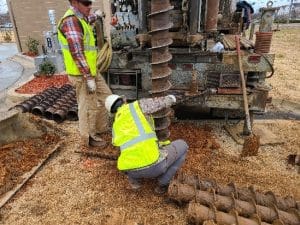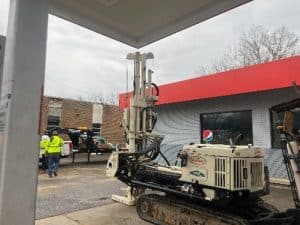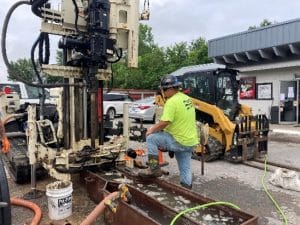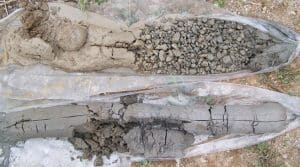 Contributed by Stephanie Evans, Staff Geologist, PPM Consultants
Contributed by Stephanie Evans, Staff Geologist, PPM Consultants
There are several well drilling methods that can be used, and choosing the best option for your specific situation will depend on several factors. Let’s take a closer look at the advantages and disadvantages of some popular drilling techniques to determine which might be the best option for your project.
Auger Methods: Augers have the appearance of a screw, where the screw threads (flights) carry the materials to the surface through the rotation of the drill stem. The bottom of the drill stem is equipped with a bit to help the auger advance into the ground. This method is useful in relatively shallow unconsolidated soils.
- Flight Auger (Solid Stem): Typically utilizes a Claw Bit to advance solid stem auger flights into the ground. The drilling equipment applies pressure against the top of the stem while turning it into the ground where the bit displaces the soil and moves it up the flights as the drill goes deeper into the subsurface.
Pros: It does not require circulation fluids, which makes site clean-up easier than some other drilling methods. The rapid drilling into soils with a lot of clay can save time and money.
Cons: The augers must be removed and sampling done in an open hole, therefore, it is not appropriate for sampling materials (loose, sandy soils) that will cave in when the augers are removed. It does not do well below the water table due to water infiltration.
- Hollow-Stem Augers: This type of drilling is similar to solid stem, except the Claw Bit is attached to a hollow stem, instead of a solid one. Flights are attached to a hollow rod that is sized to sample through the middle of the rod. There is a removable plug/bit to allow the sampling to be done without removing the drill stem. Once the borehole reaches the desired depth, the hollow stem acts as a temporary casing, keeping the side of the borehole from caving in.
 Pros: It allows for uncontaminated sampling in formations of unconsolidated soils. Since drilling fluids are not generally used with this method, there is no interference with the groundwater quality by the introduction of fluids into the borehole. It can be used to sample water quality at varying depths as the boring is advanced. Hollow-stem augering excels in non-cohesive soils such as sand and gravel. Rapid drilling into soils is relatively easy and cost-effective.
Pros: It allows for uncontaminated sampling in formations of unconsolidated soils. Since drilling fluids are not generally used with this method, there is no interference with the groundwater quality by the introduction of fluids into the borehole. It can be used to sample water quality at varying depths as the boring is advanced. Hollow-stem augering excels in non-cohesive soils such as sand and gravel. Rapid drilling into soils is relatively easy and cost-effective.
Cons: It cannot penetrate cobbles, boulders, and most rock formations. Its use is limited in loose, sandy soils where water table infiltration can contaminate sampling (sampling in loose soils requires alternate sampling equipment like a split spoon). Another challenge when using hollow-stem augers is trying to drill with flowing sands. Flowing sands is a term that drillers use when referring to a mixture of fine sand and water that infiltrates drilling equipment. The flowing sands can rise upward in the hollow-stem auger and prevent a driller from obtaining an accurate sample.
Direct-Push Methods: Direct push technology, often referred to as DPT, uses the weight of the static drill rig combined with a hydraulic/percussion hammer to advance sampling and logging tools into the subsurface.
 Pros: DPT is commonly used in the remediation field due to its small footprint and versatility. It can rapidly and cheaply obtain samples and information in borings. It works well for unconsolidated materials. Essentially no drill cuttings are generated by direct push methods. This reduces the potential for worker exposure to hazardous contaminants relative to traditional rotary drilling techniques, as well as minimizing the generation of potentially hazardous waste during site investigation.
Pros: DPT is commonly used in the remediation field due to its small footprint and versatility. It can rapidly and cheaply obtain samples and information in borings. It works well for unconsolidated materials. Essentially no drill cuttings are generated by direct push methods. This reduces the potential for worker exposure to hazardous contaminants relative to traditional rotary drilling techniques, as well as minimizing the generation of potentially hazardous waste during site investigation.
Cons: DPT is typically only useful at generally shallow depths and in unconsolidated formations. DPT is not suitable for formations containing large or excessive gravel, cobbles, and boulders or for bedrock drilling due to the lack of augering capabilities.
Rotary Methods: For rotary methods, borehole advancement is achieved by the rapid rotation -utilizing high levels of torque and rotation- of a drill bit that is mounted at the end of the drill pipe. Cuttings are then brought to the surface by the circulation of drilling fluid (drilling mud, water, foam, or air). The rotary methods are typically appropriate for deep boreholes in rock formations and can be used in both unconsolidated and consolidated materials.
- Air Rotary: Air or foam is used through the drill stem to bring the cuttings to the surface around the outside of the drill stem.
Pros: It can be used to great depths (approximately 1,000 feet below ground surface or deeper) and the borehole can be advanced relatively fast. It can be helpful when determining the top of the water table as the air begins to blow the water out of the borehole with the cuttings.
Cons: This can be problematic for contaminant investigations, as when foam needs to be added to recover the cuttings it introduces foreign materials. The collected samples are poor and more expertise is needed to interpret the cuttings. This method may not be suitable for some unconsolidated formations as there is minimal control of borehole caving if unconsolidated sands and silts are drilled.
- Mud Rotary: Water or drilling mud circulated through the drill stem is used to bring the cuttings to the surface in the annular space between the borehole wall and the drill rod.
 Pros: It can be used to make boreholes in which downhole geophysical logs can be run, can be drilled to great depth, and to get rock core samples. The borehole can also generally remain open after the drill stem has been removed.
Pros: It can be used to make boreholes in which downhole geophysical logs can be run, can be drilled to great depth, and to get rock core samples. The borehole can also generally remain open after the drill stem has been removed.
Cons: The use of circulation fluids makes site clean-up more difficult than some other drilling methods. The drilling fluid can penetrate the formations changing the groundwater chemistry.
Sonic Methods: Uses high-frequency vibration (resonance) to reduce friction and advance the borehole. Drilling fluids (both liquid and air) can be used but are not required.
 Pros: FAST – very fast drilling compared to other methods. It is useful in a wide range of soil types, including soils with large particles that are typically very difficult to sample using other techniques. It is used for numerous applications in the fields of environmental geology, engineering geology, and economic geology exploratory holes. With the sonic method, you can drill at any angle and it allows for the installation of well equipment, and the collection of relatively undisturbed soil samples and rock core.
Pros: FAST – very fast drilling compared to other methods. It is useful in a wide range of soil types, including soils with large particles that are typically very difficult to sample using other techniques. It is used for numerous applications in the fields of environmental geology, engineering geology, and economic geology exploratory holes. With the sonic method, you can drill at any angle and it allows for the installation of well equipment, and the collection of relatively undisturbed soil samples and rock core.
Cons: Depending on conditions, it may be more expensive than conventional drilling methods. Friction from the drilling processes can create high temperatures for the drill bit, and this can be unwanted because it can volatilize the organic compounds being screened reducing accuracy. However, well-trained sonic drillers know how to mitigate the heat using several different techniques.
As the old saying goes, “there are many ways to skin a cat”. A seasoned geologist will always consider all of these factors and more to determine the most quality data-producing, efficient and economic method to meet the project objectives. Feel free to reach out to me at stephanie.evans@ppmco.com if you want to discuss the options for your project.

